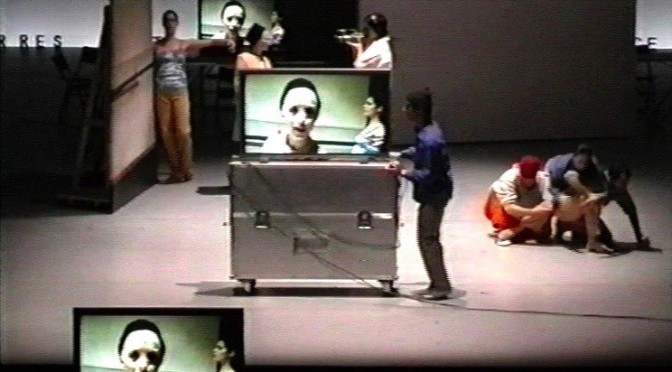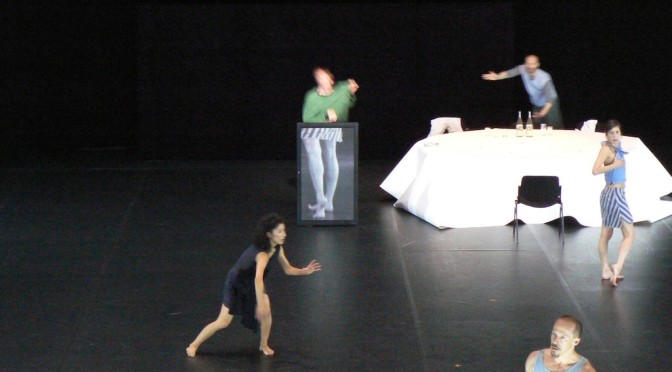With text from:
Anne Carson: »Irony is not enough: Essay on My Life as Catherine Deneuve« (2nd draft)
Douglas A. Martin: »Outline of My Lover«
Stage / Lighting / Costumes: William Forsythe
Video Design: Philip Bussmann
Film »First Touch«: Martin Schwember
Video Software »Image/ine«: Tom Demeyer / S.T.E.I.M.
»Live« Video Coordination: Agnieszka Trojak
Camera: Ursula Maurer
Music: J. S. Bach, H. von Bieber, J. S. Bach / F. Busoni, Thom Willems, Lynn Anderson: »Cry«
Sound Design: Joel Ryan
Piano: David Morrow
Actors: Dana Caspersen (Catherine Deneuve) and Antony Rizzi (Boy in the blue sock hat)
Premiere: 8 December 2000, Bockenheimer Depot, Frankfurt am Main
»Kammer/Kammer« is an adaptation of the novel Outline of My Lover by Douglas A. Martin and the essay Irony is Not Enough: Essay on my life as Catherine Deneuve by award-winning poet and scholar Anne Carson. Two love relationships unravel in a live, on-stage recording of a film constructed through a dynamically-choreographed stage and video design. Dancing bodies confront one another in this multiple, dislocated landscape, as Forsythe combines choreographic invention with a distinct theatrical vision.
Mit Texten von:
Anne Carson: »Irony is not enough: Essay on My Life as Catherine Deneuve« (2nd draft)
Douglas A. Martin: »Outline of My Lover
Bühne / Licht / Kostüm: William Forsythe
Video Design: Philip Bussmann
Film »First Touch«: Martin Schwember
Video Software »Image/ine«: Tom Demeyer / S.T.E.I.M.
»Live« Video Koordination: Agnieszka Trojak
Kamera: Ursula Maurer
Musik: J. S. Bach, H. von Bieber, J. S. Bach / F. Busoni, Thom Willems, Lynn Anderson: »Cry«
Sound Design: Joel Ryan
Piano: David Morrow
Darsteller: Dana Caspersen (Catherine Deneuve) and Antony Rizzi (Boy in the blue sock hat)
Premiere: 8 December 2000, Bockenheimer Depot, Frankfurt am Main
»Kammer/Kammer« ist eine szenische Bearbeitung des Romans Outline of My Lover von Douglas A. Martin und des Essays Irony is Not Enough: Essay on my Life as Catherine Deneuve der preisgekrönten Dichterin und Akademikerin Anne Carson. Es zeigt die Entwicklung zweier Liebesbeziehungen durch ein dynamisch choreografiertes Szenen- und Videodesign im Rahmen einer Live-Aufnahme eines Films auf der Bühne. Tanzende Körper konfrontieren einander in dieser multiplen entgrenzten Landschaft, wenn Forsythe choreografische Erfindungsgabe mit seiner Vision des Theaters verknüpft.

